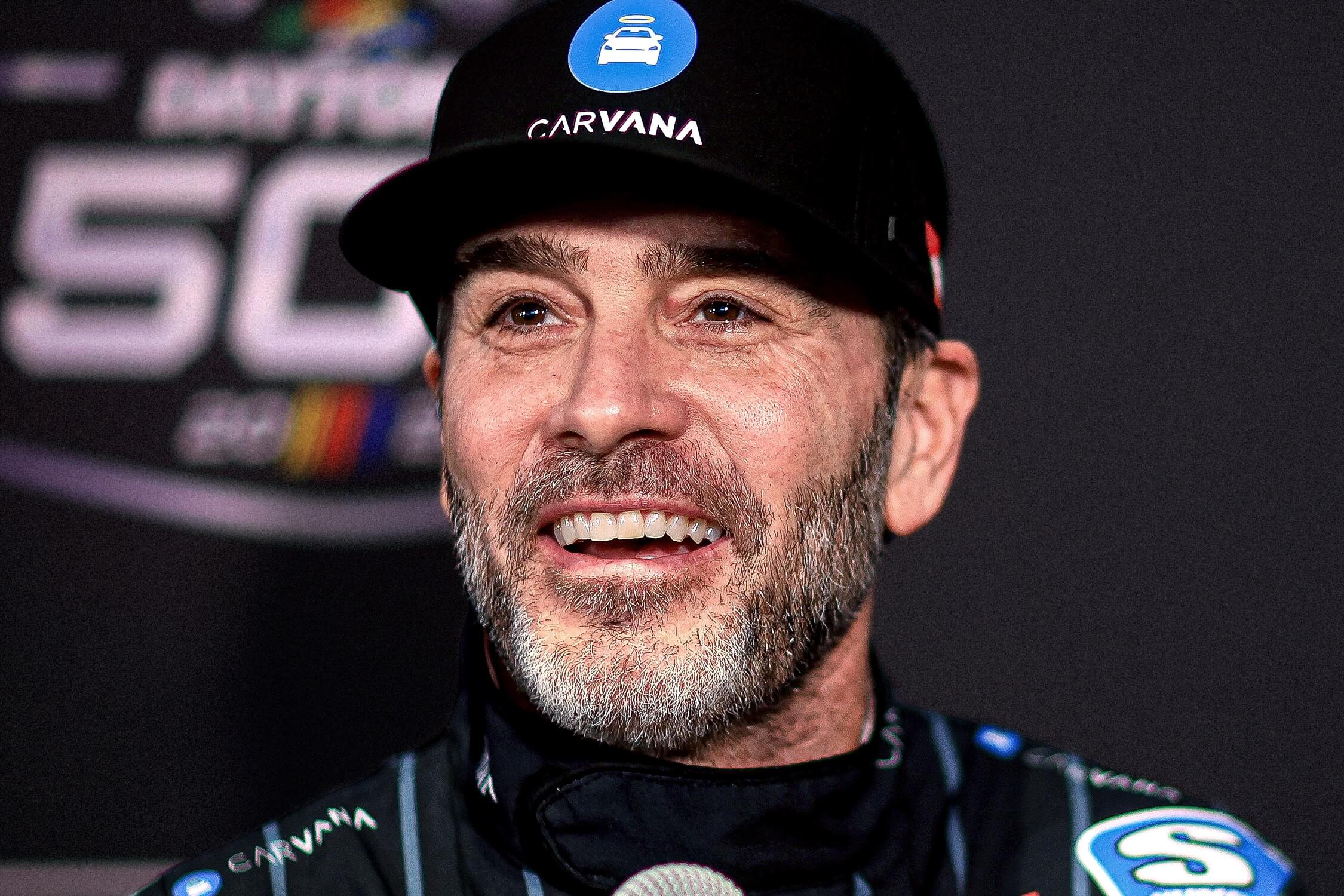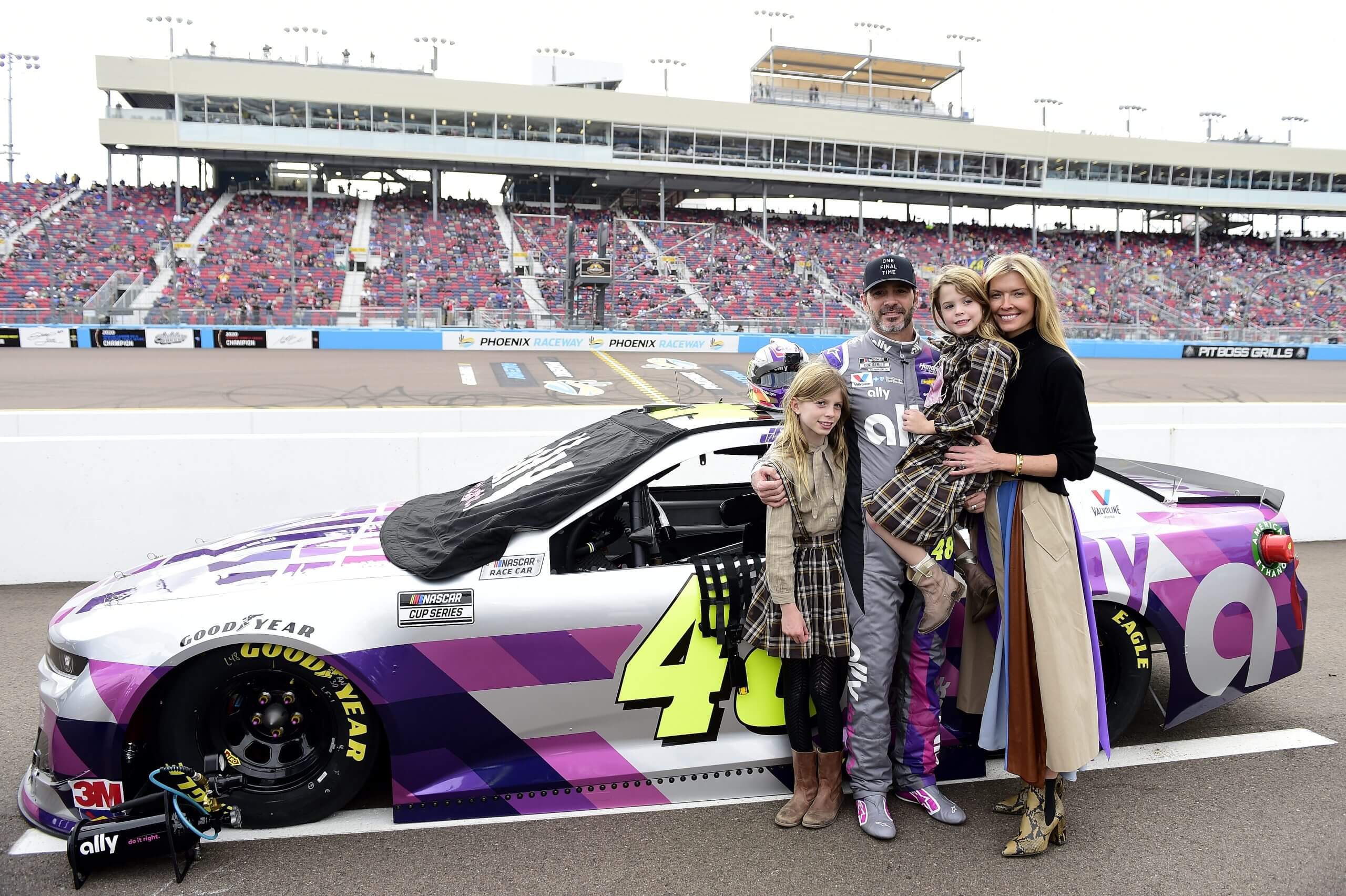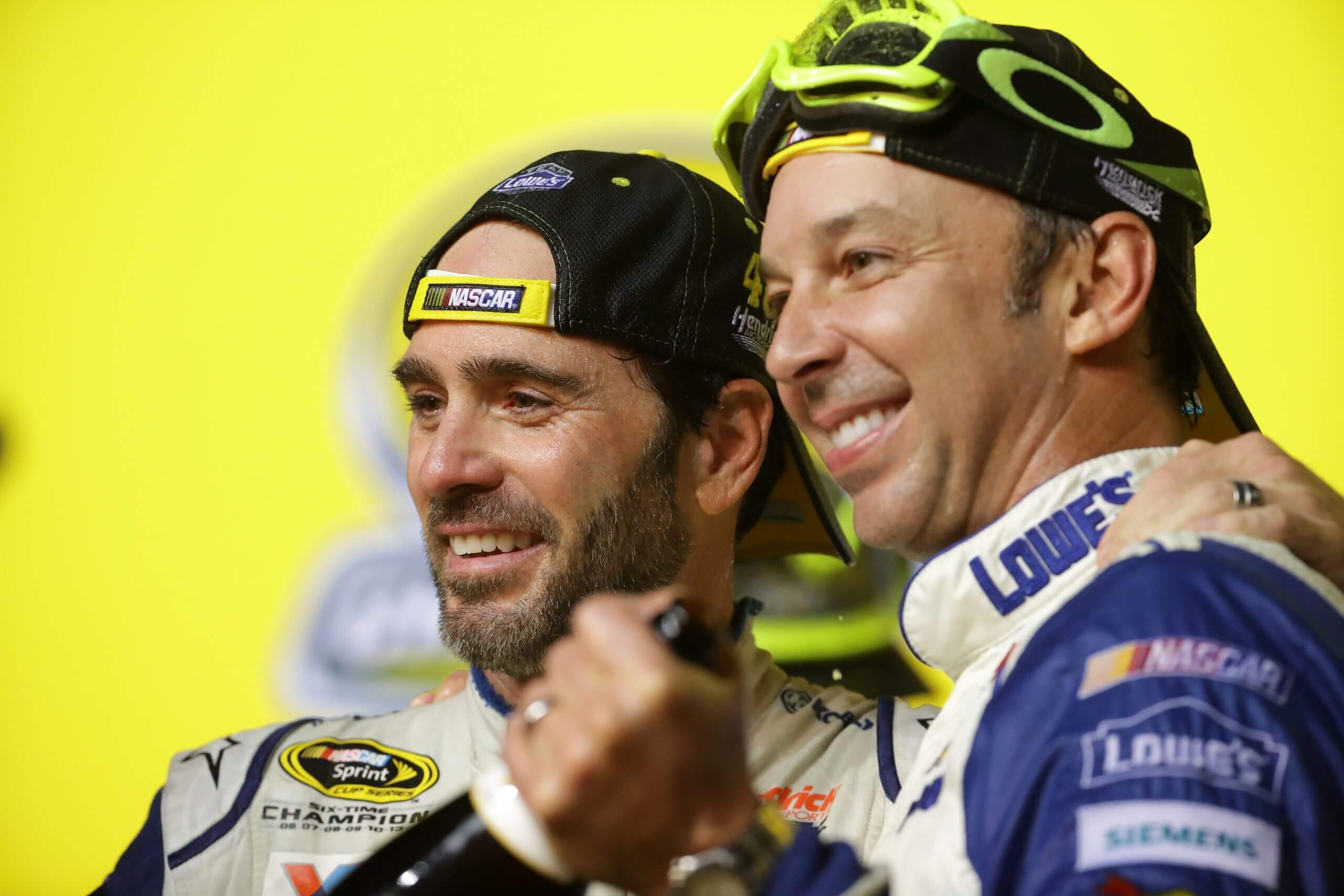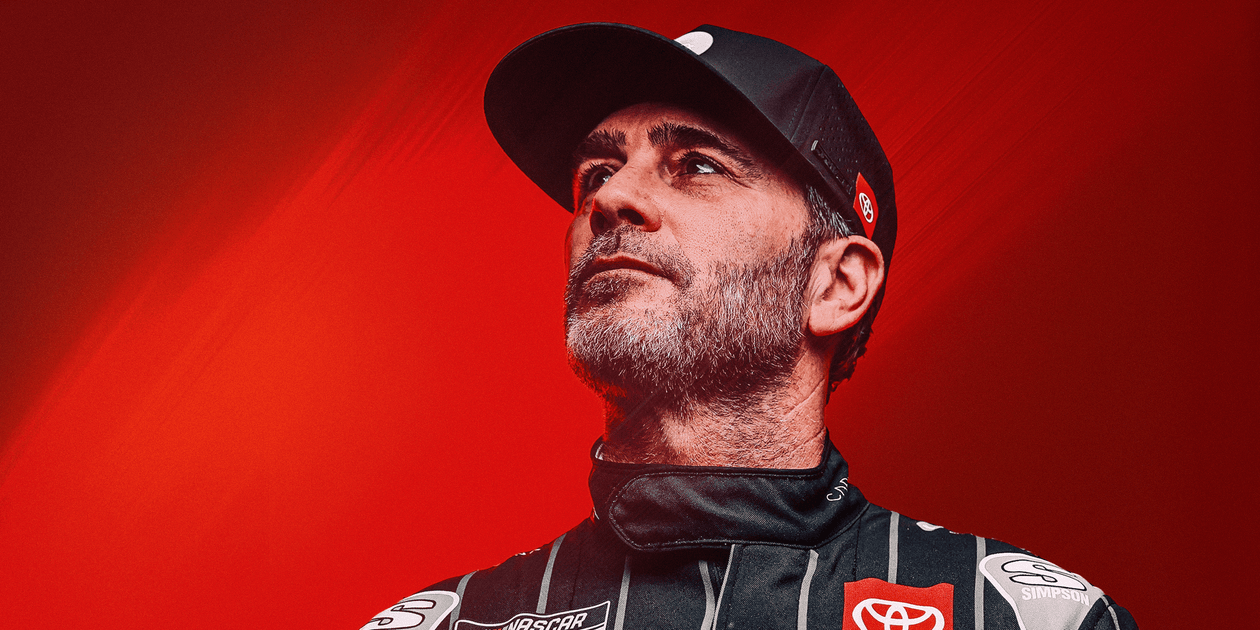It doesn’t seem like that long ago when Jimmie Johnson burst onto the NASCAR scene, given the opportunity to drive a Cup Series car at Hendrick Motorsports despite being a relative unknown and one-time winner in the Xfinity Series.
But Jeff Gordon was correct in identifying his protégé, and Johnson went on to put himself on NASCAR’s Mount Rushmore with a record-tying seven Cup Series championships and 83 Cup wins. The Californian was the best driver of his era, spanning the first decade and a half of this century.
After taking a step back from NASCAR to try his hand at IndyCar and then moving his family to the United Kingdom, Johnson is back in NASCAR and all-in — this time as a team owner.
Johnson became the majority owner of the two-car Legacy Motor Club team in January and has backing from Knighthead Capital Management, and he recently moved back to the United States on a full-time basis.
As of Wednesday, Johnson is 50 years old — not fully retired from driving yet, but a busy man with a company to run. The Athletic spoke to Johnson to reflect on his milestone birthday, his outlook on life and his approach to competition and leadership.
How is turning 50 hitting you?
It’s wild. Slowing down in some respects has helped me grasp the number. Having kids has helped, too. When I was racing all the time — even in my early 40s — you don’t ever look up. You’re just grinding and going.
I’m taking care of myself, so I feel good, and the energy is there. It’s just a number, but life is slowing down in some ways. Gosh, it’s wild. In my head, 50 as a kid seemed old, you know? And damn … here it is.
On your “Never Settle” podcast, you and co-host Marty Smith recently spoke about how 50-year-olds didn’t used to look the way you guys do now. In other words, you still look young. But do you feel 50 mentally?
I don’t feel 50 mentally, and part of that is I still have so much to learn. Being an athlete, you’re exposed to a lot, but when I look around at friends who are 50 and in the workforce, their skill sets are so well-rounded in the “real world” compared to an athlete or race car driver.
As athletes, we’re highly focused in a few areas, but not as well-rounded as others. This journey on the ownership side — running a company, operations, all the different layers to it — has been a crash course. I don’t know what half the acronyms mean when I sit in a meeting. There are things I’ve never experienced: having an HR person to talk to or report to, all these basics for the business world that are brand new to me at 50.

“This journey on the ownership side … has been a crash course,” Johnson says of his role with Legacy Motor Club. “I don’t know what half the acronyms mean when I sit in a meeting.” (Mike Ehrmann / Getty Images)
Let’s talk about being a parent. For me, having kids really makes me feel my age. How has watching your daughters grow up affected you as you turn 50?
(Oldest daughter) Evie is 15 now. We just dropped her off at boarding school this month, and gosh, what an emotional roller coaster it’s been. She advocated for this move, but that doesn’t make it any easier for her or for us when saying goodbye and leaving.
We thought we had until 18, so 15 feels ahead of schedule — really interesting and difficult. When your kids are younger, you’re so busy. There’s a lot of time, but to relate and have a deep relationship looks different.
(Youngest daughter) Lydia just turned 12, and she’s moving into this relational stage with us, while Evie is already deep into that. The time just flies by. It’s the most precious commodity we all have.
Now Evie is away and busy, I’m busy, and the time element is tough. We’re not the first parents to do this, though, and we have great friends to share stories with about how they’ve navigated similar things. It’s been a journey, and it has definitely made me realize my age — especially a couple of weeks ago when the driver’s ed teacher showed up, and Evie drove out of the driveway behind the wheel. I thought, “What’s going on here?”
Your legacy as a driver was secure a long time ago, but you’ve said you’re not retired. When you get behind the wheel for the occasional race now, what are you looking for — fun, feedback for the team, a challenge?
It’s really about having fun now. The more time I spend around the Cup Series with this generation of car, the more I realize my chances of having a real shot to win — unless it’s at Daytona or Talladega — are slim. These Next Gen cars are so different, and the guys who do it every single day keep inching away from people like me who moonlight a few times a year.
So my goals have shifted: If it helps the team, I’m in. If I get to go out there and have fun, I’m absolutely in.
Strategically, we’re looking at hopefully having a third charter in 2027 (Legacy is currently involved in litigation with Rick Ware Racing over a charter purchase gone awry). If there’s a way I can help the team in 2026, maybe. But there are so many unknowns. Really, it’s about having fun for me right now.
Can you describe how different the Next Gen car feels compared to what you drove for most of your career?
The pace of play is down a little — they’re not as fast — but the work cycle is very different. With a short, 25-minute practice session and then qualifying, you can’t go out there, get used to the car, make adjustments and feel what different changes do.
Everything is developed in the simulator now. When you unload at the track, it is what it is — you’re stuck with that setup for the weekend. To find what you need as a driver, you really need to do it every week so the car shows up at the track in the form you want. Coming in just a couple of times a year, there’s no way for me to build those fine touches into the car or the setup.
If there were two hours of practice like we used to have, it would be a different conversation. But the way the car drives — and the way the weekend is structured — really tilts things toward the regular drivers.

Jimmie Johnson, with daughters Evie (left) and Lydia and wife Chandra, at his final race as a full-time Cup Series driver at Phoenix Raceway in 2020. (Jared C. Tilton / Getty Images)
You could have stayed retired, but you came back as a team owner. Why was NASCAR ownership something you had to do?
I’m finding there are other ways to fulfill the adrenaline rush of being in the car. A month ago, I did some historic racing and even drove a boat — those things scratched that itch in a way I didn’t expect.
But honestly, watching our cars (driven by Erik Jones and John Hunter Nemechek) fight for wins recently filled a bucket in a way I wasn’t prepared for. I always thought I had to be the one holding the wheel, but now seeing the team compete is incredibly fulfilling.
Ownership is so competitive — not just what you see on track Sunday afternoons. There’s competition for your workforce, for sponsors. We’re racing and competing in every area of the business. I’ve got all the steering wheel I need now to fulfill that competitive drive. The more I get into this, the more I realize Mr. Hendrick was right all along.
You’ve been praised for being a great listener as a leader. Why is that so important to you?
I’m trying to develop and figure it out. I’ve always been the one talking — complaining about what was wrong with my car and letting others fix it. That’s not my role anymore.
When I was in the 48 car, I focused on creating the right locker-room environment. That’s something I’m really passionate about for Legacy Motor Club. I want our team to embody that internally, and for people to see it externally.
The picture in my mind comes from college football: those locker room shots before the team runs out of the tunnel. In motorsports, you never really see that. I want to create it — not as a show, but internally, within our walls and transporters. That passion and commitment makes us better. When the 48 car had that culture, we ran better. There’s secret sauce there, and that’s what I want for Legacy.
You have said one of the biggest surprises as an owner is how long it takes to find speed and make gains. How do you balance patience with knowing when it’s time to make changes?
I’ve been asking myself that same question. That’s where listening comes in. Every race has a story. Every success or failure has a story. I try to find patterns and be realistic about where we are and where we need to go.
The best way I’ve found is by surrounding myself with people I trust — people who have been here before and know how long we need to be patient, and when we need to start working in parallel on other plans. If we need to change course, they help me map out what that might look like.
I’ve always been patient. With the 48 car, (crew chief) Chad Knaus was impatient for all of us. (Laughs.) So my role was to provide perspective and help pick up the pieces. That’s my natural headspace. But I also don’t want to be asleep at the wheel.
There are two things I circle back to constantly. One is accountability. There are always more layers of accountability — for departments, individuals, the equipment we’re taking to the track. The second is communication. You can never communicate enough.

Jimmie Johnson and Chad Knaus celebrate their 2016 NASCAR Cup Series title, the last of the duo’s seven championships. Knaus is now VP of competition for Hendrick Motorsports. (Sarah Crabill / Getty Images)
It seems like your role has flipped — now you embrace the handshaking, the suites, the ambassador role. Those are things you shied away from when you were focused on driving. Why do you enjoy that now?
When we got started in 2023, my vision was to do something different in NASCAR and in North American racing — to be more than just a team, but a brand. NASCAR is our core product, yes, but I want to appeal to a broader group and audience.
There’s so much love for motorsports right now. Formula One has helped bring all forms of racing more attention in the U.S., and I think there are untapped opportunities for us or anyone. It’s taken us a little while to get some air under our wings, but that’s starting to happen on track, so it’s allowing us to spend more time with the Club and other elements that we want to roll out and you’ll start seeing soon.
As a driver, I needed constant accountability and pressure to perform. My off-road owner, Jon Nelson, and then Chad Knaus, rode me hard — and I didn’t love it, but it made me better. I realized I had to be a bit uncomfortable. I didn’t want to socialize or be in a great mood walking through the garage because I needed that pressure to succeed.
Now, as an owner, it’s different. The role requires me to embrace those interactions and represent the team. It’s a whole different headspace.
How do you hold yourself accountable now that there’s no one above you pushing you?
Right now, it’s fear. Fear of survival. This isn’t cheap. Today’s racing has more of a business plan than ever, but we’re eager to buy a third charter — and that’s going to put debt on the business.
That fear is a motivator to bring my best work every day.
Is there anything we didn’t touch on that you’d like people to know about what you’re thinking as you turn 50?
Not specifically — just that it’s a journey I’m still figuring out. I’m learning every day. Our team is growing, and I’m incredibly proud of the people who’ve joined me on this path. It’s hard work, but it’s fulfilling in ways I never expected.
(Top photo: Meg Oliphant / Getty Images)

